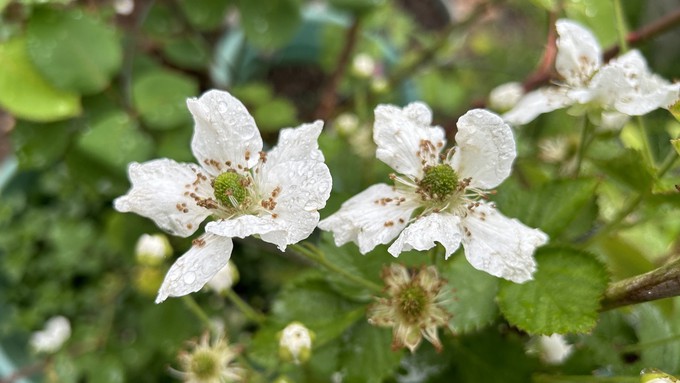
April showers will give way to plenty of sunshine

Rain-dotted blossoms on a Baby Cakes blackberry bush show the little berries developing at the center. Saturday was plenty cold and wet, but by Tuesday the high temperature will be back in the 70s. Kathy Morrison
Talk about weather whiplash! Two days after afternoons in the 80s, noon Saturday (April 13) in Sacramento was wet and a very chilly 47 degrees.
Our wild weather continues this week. Fast-moving thunderstorms made for a soggy weekend, but that rain won’t stick around. By Tuesday, Sacramento can expect a high of 76 degrees, according to the National Weather Service. Wednesday, Thursday and Friday are all forecast in the low 80s.
Overnight lows are remaining stubbornly chilly, dipping down into the 40s each night. But nights also are starting to edge warmer. By next weekend, we should see lows in the mid 50s, says the weather service.
That’s still not warm enough to transplant tomatoes directly in the ground, but we’re getting there.
After Saturday’s wet weather, soil will be soft and easy to work this week. So, dig in! (Wait a few days, though, to avoid walking on or working soggy soil that could become compacted.)
* April is the last chance to plant citrus trees such as dwarf orange, lemon and kumquat. These trees also look good in landscaping and provide fresh fruit in winter.
* Smell orange blossoms? Feed citrus trees with a low dose of balanced fertilizer (such as 10-10-10) during bloom to help set fruit. Keep an eye out for ants.
* Apply slow-release fertilizer to the lawn.
* Thoroughly clean debris from the bottom of outdoor ponds or fountains.
* Spring brings a flush of rapid growth, and that means your garden is needs nutrients. Give shrubs and trees a slow-release fertilizer. Or mulch with a 1-inch layer of compost.
* Are azaleas and camellias looking a little yellow? If leaves are turning yellow between the veins, give them a boost with chelated iron.
* Trim dead flowers but not leaves from spring-flowering bulbs such as daffodils and tulips. Those leaves gather energy to create next year's flowers. Also, give the bulbs a fertilizer boost after bloom.
* Pinch chrysanthemums back to 12 inches for fall flowers. Cut old stems to the ground.
* Mulch around plants to conserve moisture and control weeds.
* From seed, plant beans, beets, cantaloupes, carrots, corn, cucumbers, melons, radishes and squash.
* Plant onion sets.
* In the flower garden, plant seeds for asters, cosmos, celosia, marigolds, salvia, sunflowers and zinnias.
* Transplant petunias, zinnias, geraniums and other summer bloomers.
* Plant perennials and dahlia tubers for summer bloom.
* Mid to late April is about the last chance to plant summer bulbs, such as gladiolus and tuberous begonias.
* Transplant lettuce seedlings. Choose varieties that mature quickly such as loose leaf.
Comments
0 comments have been posted.Sacramento Digs Gardening to your inbox.
Sites We Like
Garden Checklist for week of July 21
Your garden needs you!
* Keep your vegetable garden watered, mulched and weeded. Water before 8 a.m. to reduce the chance of fungal infection and to conserve moisture.
* Feed vegetable plants bone meal, rock phosphate or other fertilizers high in phosphate to stimulate more blooms and fruiting. (But wait until daily high temperatures drop out of the 100s.)
* Don’t let tomatoes wilt or dry out completely. Give tomatoes a deep watering two to three times a week.
* Harvest vegetables promptly to encourage plants to produce more. Squash especially tends to grow rapidly in hot weather. Keep an eye on zucchini.
* Pinch back chrysanthemums for bushy plants and more flowers in September.
* Remove spent flowers from roses, daylilies and other bloomers as they finish flowering.
* Pinch off blooms from basil so the plant will grow more leaves.
* Cut back lavender after flowering to promote a second bloom.
* It's not too late to add a splash of color. Plant petunias, snapdragons, zinnias and marigolds.
* From seed, plant corn, pumpkins, radishes, winter squash and sunflowers.